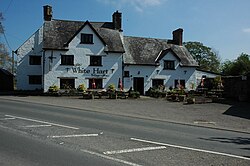
Llanvair Discoed is a small village in Monmouthshire, south-east Wales, 6 miles west of Chepstow and 10 miles east of Newport.
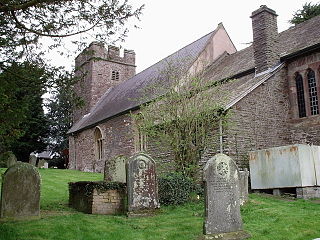
Llangybi is a village and community in Monmouthshire, in southeast Wales, in the United Kingdom. It is located 3 miles (4.8 km) south of the town of Usk and 5 miles (8 km) north of Caerleon, in the valley of the River Usk.

LlanvihangelCourt, Llanvihangel Crucorney, is a Tudor country house in Monmouthshire, Wales. The architectural historian John Newman, in his Gwent/Monmouthshire volume of The Buildings of Wales series described the court as "the most impressive and richly decorated house of around 1600 in Monmouthshire". The origins of the house are medieval, with a traditional date of construction of 1471. The building was given its present appearance by a substantial enlargement and re-casing of circa 1600 by Rhys Morgan, of the family of the original owners. In the very early 17th century it was owned briefly by Edward Somerset, 4th Earl of Worcester.

Wonastow Court, in Wonastow, Monmouthshire, Wales, is a 19th-century country house with earlier origins and later additions. The court is a Grade II listed building, and its gardens are listed, also at Grade II, on the Cadw/ICOMOS Register of Parks and Gardens of Special Historic Interest in Wales.
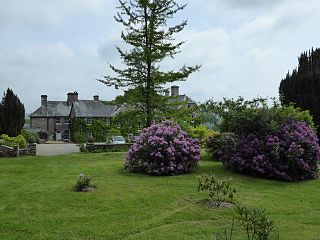
The Argoed, Penallt, Monmouthshire, Wales, is a Victorian country house dating from the 1860s, with earlier origins from the late 16th and early 17th centuries. It is a Grade II* listed building and the garden is listed on the Cadw/ICOMOS Register of Parks and Gardens of Special Historic Interest in Wales. The English meaning of the Welsh word argoed is 'by a wood'.

Lydart is a dispersed hamlet within the community of Mitchel Troy, Monmouthshire, Wales. It is located about 3 miles (4.8 km) south-west of Monmouth, 3 miles (4.8 km) north of Trellech, and 1 mile (1.6 km) south-east of Mitchel Troy village, on the top of an escarpment which slopes steeply down to the valley of the River Trothy. The B4293 road passes through the area.

Tregrug Castle or Llangibby Castle is a ruin in Monmouthshire, Wales, located about 1 mile (1.5 km) to the north of the village of Llangybi, close to the settlement of Tregrug.

The Church of St Cybi, Llangybi, Monmouthshire is a parish church with its origins in the 13th or 14th century. Refurbished in the 15th century, the church was restored in 1909–10. The interior has a notable collection of medieval wall paintings, in particular a Christ of the Trades, dating from c.1460. The church is an active parish church and part of the recently-formed Heart of Monmouthshire Ministry Area. It is a Grade II* listed building and the architectural writer John Newman, recording the church in the Buildings of Wales series, described it as "one of the most interesting in the Usk Valley."

Ynys Hafod, Henllys and Min Yr Afon, New Market Street, Usk, Monmouthshire, are three houses forming a continuous range in the centre of the town. Each house is a Grade II* listed building.

30 Bridge Street, Usk, Monmouthshire, is a building dating from the very early 15th century. In the 17th century the structure was used as a gaol and the Catholic martyr David Lewis was imprisoned there in 1678. 30 Bridge Street is a Grade II* listed building.

Little Llwygy Farmhouse, Cwmyoy, Monmouthshire, Wales, is a farmhouse of two building dates, the earlier of the 15th century, the latter of the 17th. The farmhouse is a Grade II* listed building.

The Church of the Holy Cross, Kilgwrrwg, Monmouthshire, Wales, is an early medieval parish church that once served a now abandoned village. A Grade II* listed building, the church remains an active parish church and is part of the Severn Wye Ministry Area.

Great Pool Hall, Llanvetherine, Monmouthshire is a mansion dating from the early 17th century. Its construction is unusual in that it is built around a timber frame, unlike the more common stone construction of houses of this date and location. It is a Grade II* listed building. The associated gate piers and garden walls, and the separate barn have their own Grade II listings.
Llanddewi Court, Llangybi, Monmouthshire, Wales, is a Grade II* listed house dating from the late 16th century. It is an example of a "double-house", a building in two sections, originally without interconnections, and designed to accommodate two families.

Ton Farmhouse, Llangybi, Monmouthshire is a farmhouse dating from the early 17th century. John Newman, in his Monmouthshire Pevsner, describes it as a "perfect Monmouthshire farmhouse". Ton is a Grade II* listed building, its listing noting that it is a "remarkably good survival" of a prosperous 17th century Welsh farmhouse.
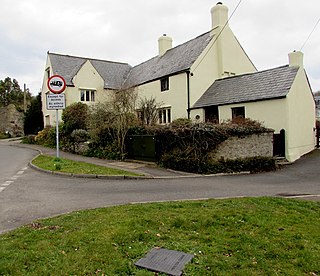
Manor Farmhouse and Manor Cottage, Portskewett, Monmouthshire is a country house dating from early 17th century. The house is a Grade II* listed building.

The barn, stable and granary at Cwrt y Brychan , Llansoy, Monmouthshire are a range of farm buildings constructed in the 16th century. The origins are the site are ancient and the court is historically connected with the kingdom of Brycheiniog. The complex has a Grade II* listing, with the court having a separate Grade II listing.
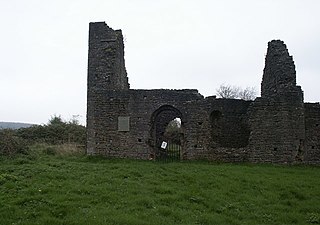
Runston Chapel, Mathern, Monmouthshire, Wales, is the ruin of a chapel dating back to the early 12th century. It is the only remaining visible remnant of the medieval village of Runston, although parts of the former domestic dwellings can be identified under turf-covered mounds on the site. Twenty-five such structures have been identified. By the 16th century, the village was in decline and, by 1785, had been entirely abandoned. The ruins of the chapel, and the site, are in the care of Cadw.

Kemeys Manor, Langstone, Newport, Wales, is a manor house dating from the 13th century. The family that built it was established in South Wales in the Middle Ages by Edward, Lord of Kemeys and the manor was held by his descendants until the 18th century. The building was greatly enlarged in the 16th and 17th centuries and comprises a tower, hall and attached ranges. Kemeys is a Grade II* listed building. A barn to the north of the house, and Kemeys Folly to the south, are both listed at Grade II. The park surrounding the house is listed Grade II on the Cadw/ICOMOS Register of Parks and Gardens of Special Historic Interest in Wales. The manor and the folly remain private residences and are not open to the public.

Monmouthshire is a county of Wales. It borders Torfaen and Newport to the west; Herefordshire and Gloucestershire to the east; and Powys to the north. The largest town is Abergavenny, with other large settlements being Chepstow, Monmouth, and Usk. The present county was formed under the Local Government (Wales) Act 1994, which came into effect in 1996. It has an area of 850 km2 (330 sq mi), with a population of 93,200 as of 2021. Monmouthshire comprises some sixty per cent of the historic county, and was known as Gwent between 1974 and 1996.
